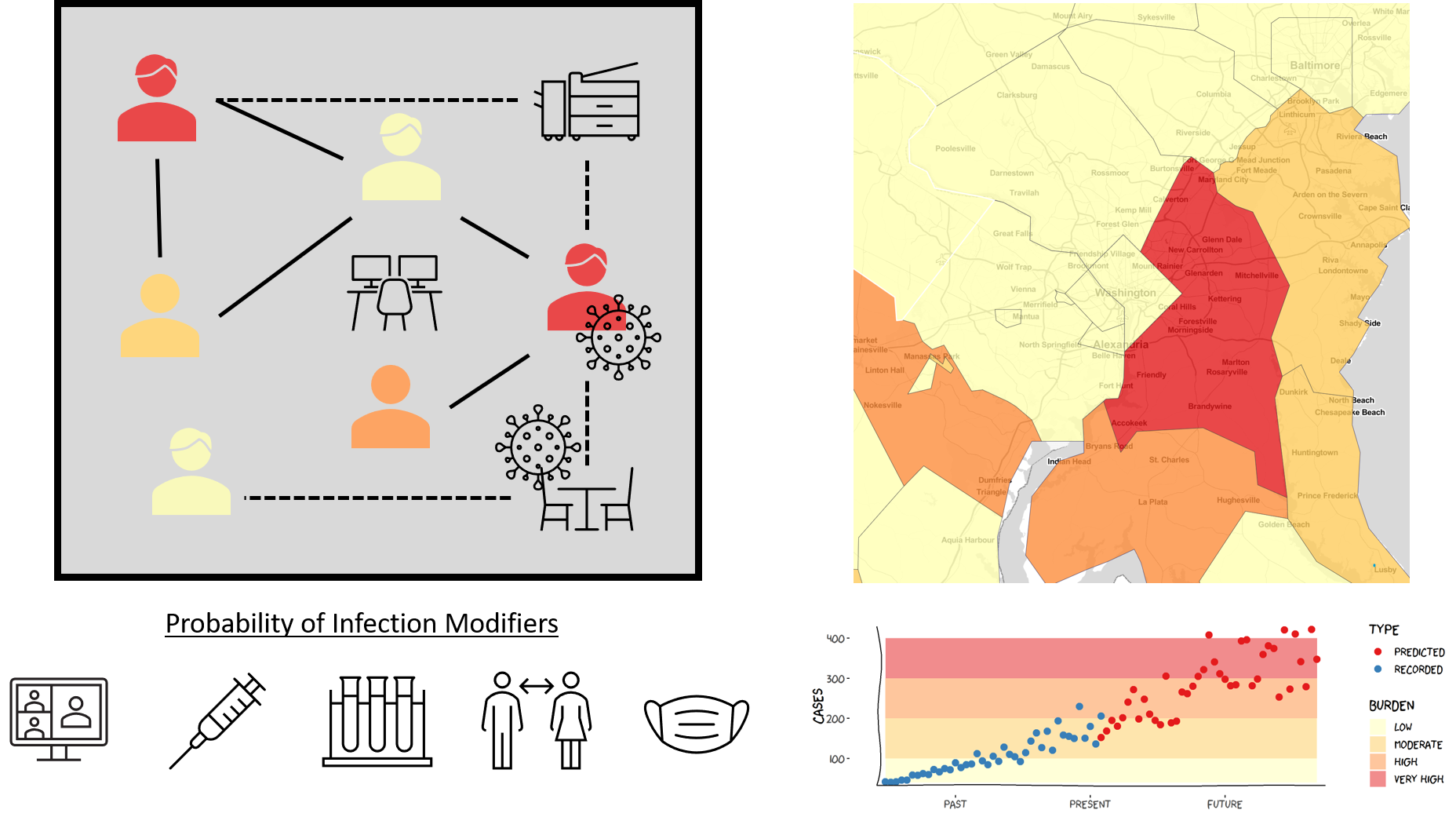Graph COP Community Coding Sessions
This is a repo dedicated to community coding sessions in which we get together and trouble shoot problems related to graphs.
- Code: Contains code used during the session
- Data: Contains data either sythesized during a session or obtained to be used during a session.
- Images: Contains images and gifs meant for reporting
Installing local packages
devtools::install("./path/to/package")
or
install.packages("./path/to/package/root/dir", repo = NULL, type = "source")
Getting familiar with the code
The infection.graph package uses modules to extend a network based discrete time SIR model.
Modules have two components:
init - how should this module modify initial conditions
next - how should this module modify conditions in the next time step
Modules are combined to create an infection model which is then run on a particular network (g).
The network is either generated synthetically or created by surveying individuals in group. (plan to extend with ergm)
To get the central tendencies of system, we run infection model hundreds or thousands of times to create a distribution outcomes.
Summary of Approach
SARS-COV-2 infections result from interactions at fine spatial and temporal scales; however, case clusters occur within a larger scale epidemiological context. Appropriately integrating the interactions between processes that occur across spatial and temporal scales is essential for simulating systems of disease transmission and understanding infection risk. Here we present a simulation engine that places a fine scale network based infection model within the broader epidemiological context of the study population. Using this system, we are able to simulate seeding events and fully explore the control strategy space.
Our simulation engine can integrate a spatially explicit COVID-19 case estimation technique at the county scale with institution level disease transmission at a “building” scale. The case estimation technique takes into account location specific factors around infection control and population level movement to estimate disease burden in a given location. The institution level model uses a multigraph to integrate social and spatial contact networks under various hazard reduction strategies at two different time scales (24 hour and 15 min segements). This allows us to model individual level interactions in the local context of the COVID-19 pandemic, opening a closed system to external forces.
Our model provides realistic estimates of SARS-COV-2 outbreaks and the ability to discover novel control strategies. By integrating models at multiple scales, our simulation engine empowers decision makers to develop location specific preparedness policies based on realistic estimates of how SARS-COV-2 will spread through their institutions.

Install git
Here is a link to the official install page Just download the software and run it if you dont want to install via command line.
Git Basics
- Remote: the remote server where our files live
- Local: your computer
- Repo: code repository
clone: used the first time you want to copy a repo from remotebranch: a divergence from the main code base. Usually used for feature development or bug fixes. Branches can come off of branches as we will see later.status: tells you if you have modified, untracked, or staged files on your local repo and where you stand relative to the remote.pull: updates your local with what is on the remoteadd: prepares a file for commitcommit: commit lets you track a change to a file, requires a message. These should be brief but informative.push: moves your local commits to remotecheckout: switch from one branch to anothermerge: join two branches
get the remote on your computer
In your git terminal/gui navigate to the appropriate folder on local.
cd my/folder/for/repo
clone the repo from remote with the proper URL into that folder.
git clone HTTPS:some/remote/url
Move files or folders into your repo if needed
Your repo folder is now being tracked by git. When you change branches files may disappear or be added based on changes others have made.
You can add files and folders like normal, just know they will be tracked by git.
If you are generating files you would like git to ignore, put the path in the .gitignore file.
Add files to the stage
To add files, use the following command:
git add some/folder/fileName
Commit files
To locally commit the changes you have staged via add, run the following:
git commit -m "informative but brief message"
Push changes to remote
To have you changes show up on the remote:
git push
Pull changes on remote to local
git pull
Check your status
git status
this lets you know what you have changed on your local branch.
Typical git workflow
Check the branch you are working on
git pullremote changes on to local, resolve any issues- make some changes to a file
git statuslook at your files on local and relationship to remotegit add some/folder/fileafter making incremental but meaninful changes to filegit commit -m "brief and informative message"those filesgit pushchanges to remote - you may be prompted to pull because of changes on remote. Do that. Deconflict the files if needed. Add and commit the deconflicted files then try your push again.
Commiting more frequently is better cheatsheet
Creating Branches
While on main branch
git checkout -b feature/Name
For first push, set it up stream
git push -u origin feature/Name
Ready to merge into main? Make a pull request
- describe the changes you made and the expected outcome
- connect to a work item
- assign a reviewer
- merge into main
Reviewing code
So you got a pull request, now what? Checkout the branch, make sure the code runs as expected. Reference the description to
the work item and make sure they align. If the code doesn't run, or the feature doesn't match the work item/description,
talk with the person who submitted the pull request. Do not approve a PR that does not run. After you approve the pull request,
talk with the author of the code to determine who will merge the code into dev and merge with a stand merge (not fast forward).
Creating a branch of a branch
